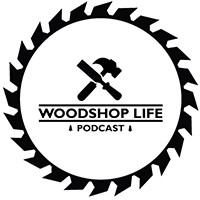Support us on Patreon: https://www.patreon.com/woodshoplife
Guy
1) I’ve been woodworking nearly 4 years and do it as a part time business. This year, business has really taken off and I’m getting several large commissions. Because of this, I finally pulled the trigger on a Fuji Q5 Platinum HVLP. I figured if I was gonna spray… go all the way. My question for you gentlemen: I am convinced that Conversion Varnish is a very high quality finish I would like to use; do you all have any that you have used any loved? Any that you hate? Since many are water-based, should I spray shellac first to pop the grain? Thank you! Nathan
2) Hey Guys. Table saw technique question for you: when ripping narrow stock from a wider board do you prefer the narrow rip against the fence (let’s say it’s a 2” rip for discussion purposes) when ripping down a wide board or do you prefer to keep the wide board between the fence and the blade and use a stop block or a thin rip block and constantly move the fence? Assuming the thin rip against the fence is more accurate but are either techniques safer? Ben
Sean
1) Hey I love your guys show. You guys are lucky to have Guy on your staff. Every act needs a straight man. He’s a good one. LOL so my question is this. In making tabletops is there a standard width of board you prefer. That is, if you have to cut down something wider you typically go for a 8in wide board, 6 in, 12 in. board? – Marlan
2) I’m probably going to get one of the Rigid oscillating belt and spindle sanders that everyone seems to like a lot. But I’ve also had my eye on a 12 inch disc sander. Mainly now I will be using them to sand to lines on curves cut with a bandsaw. Wondering what I would be able to to do in addition to that if I had the disc sander, or whether it’s overkill to have both. Thanks, and don’t let Guy answer my question first 🙂 Just kidding — you’re great, Guy! – Adam
Huy
1) Can you share any info or help for vacuum hoses? How many sizes are there? I have 7 different types of shop vacs ( some for the shop, some for job sites and one for water) and it seems like every one has a different size hose. I have reducers and tons of other fittings, but it seems like half the time I am taping them to the tool I am using. Is this a common problem? I also have 2 portable dust Collectors. I thought about painting each size a different color and then just match them up – Tomakazi
2) I picked up a Festool TS55 last fall, and have been slowly getting more familiar with it. I’m working towards getting an MFT style top for an outfeed table, and came across an older (2013?) video on Guy’s YT channel showing a setup using an Incra fence with stops on an MFT outfeed table. I’m curious if you still use that sort of setup, and if you’d go with the same method for attaching the fence today vs. something like the FenceDogs from BenchDogs.uk or PrecisionDogs.us (not released yet). Any discussion on using a track saw on an MFT type table for cross cuts, with stops, etc. would be welcome. -Monte
